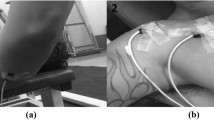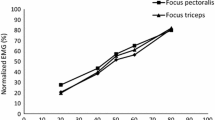Abstract
We studied the regulatory mechanisms underlying isometric and concentric muscle contractions in athletes adapted to stereotypical and situational motor activities. It has been found that the total electromyography (EMG) amplitude of the studied muscles in basketball players during isometric and concentric contractions to voluntary failure in the final period (phase) of contractions decreases, as compared with the initial phase, while the EMG amplitude in short- and long-distance runners was more stable throughout the whole contraction duration. This EMG dynamics was accompanied by certain changes in the amplitude and frequency of EMG turns, confirming that electrical activity in the motor units of muscles is differently organized in basketball players and runners. The coordination structure of the performed isometric and concentric contractions is probably determined by the specificity of the motor program pool formed in athletes during their adaptation to different types of training.

Similar content being viewed by others
REFERENCES
Farfel’, V.S., Upravlenie dvizheniyami v sporte (Movement Control in Sports), Moscow: Sovetskii Sport, 2011.
Platonov, V.N., Sistema podgotovki sportsmenov v olimpiiskom sporte: obshchaya teoriya i ee prakticheskie prilozheniya (The System of Athlete Training in the Olympic Sport: General Theory and Practical Applications), Kyiv: Olimpiiskaya Literatura, 2015, book 2.
Monda, V., Valenzano, A., Moscatelli, F., et al., Primary motor cortex excitability in karate athletes: a transcranial magnetic stimulation study, Front. Physiol., 2017, vol. 8, p. 695.
Viru, A.A., Gormonal’nye mekhanizmy adaptatsii i trenirovki (Hormonal Mechanisms of Adaptation and Physical Training), Leningrad: Nauka, 1981.
Volkov, N.I., Bioenergetics of Sports Activity, Moscow, 2010.
Andriyanova, E.Yu. and Lanskaia, O.V., Functional plasticity of spinal circuits in long-term sports activity adaptation, Hum. Physiol., 2014, vol. 40, no. 3, p. 299.
Lanskaya, O.V. and Lanskaya, E.V., Specific skeletal muscle evoked responses in representatives of various sports caused by magnetic and electrical stimulation of the central and peripheral structures of the nervous system, Nauka Sport: Sovrem. Tendentsii, 2017, vol. 16, no. 3, p. 39.
Zenkov, L.R. and Ronkin, M.A., Funktsional’naya diagnostika nervnykh boleznei: rukovodstvo dlya vrachei (Functional Diagnostics of Nervous Diseases: Manual for Physicians), Moscow: MEDpress-Inform, 2014.
Kozlovskaya, I.B., Afferentnyi kontrol’ proizvol’nykh dvizhenii (Afferent Control of Arbitrary Movements), Moscow: Nauka, 1976.
Latash, M.L. and Zatsiorsky, V.M., Biomechanics and Motor Control: Defining Central Concepts, New York: Academic, 2016.
Fel’dman, A.G., Tsentral’nye i reflektornye mekhanizmy upravleniya dvizheniyami (Central and Reflex Mechanisms of Movement Control), Moscow: Nauka, 1979.
Nicholls, J., Wallace, B., Fuchs, P., and Martin, A., From Neuron to Brain, Sunderland, MA: Sinauer, 2001.
Gorodnichev, R.M. and Shlyakhov, V.N., Fiziologiya sily: monografiya (Physiology of Power: Monograph), Moscow: Sport, 2016.
Evarts, E.V., Representation of movement and muscle by pyramidal tract neurons of the precental motor cortex, in Neurophysiological Basis of Normal and Abnormal Motor Activity, New York: Raven Press, 1967, p. 215.
Seki, K., Perlmutter, S.I., and Fetz, E.E., Task-dependent modulation of primary afferent depolarization in cervical spinal cord of monkeys performing an instructed delay task, J. Neurophysiol., 2009, vol. 102, no. 1, p. 85.
Shadmehr, R., Smith, M.A., and Krakauer, J.W., Error correction, sensory prediction, and adaptation in motor control, Annu. Rev. Neurosci., 2010, vol. 33, p. 89.
Author information
Authors and Affiliations
Corresponding author
Additional information
Translated by N. Tarasyuk
Rights and permissions
About this article
Cite this article
Popovskaya, M.N., Moiseev, S.A., Ivanov, S.M. et al. Different Types of Muscle Contraction Regulation in Athletes Adapted to Stereotypical and Situational Motor Activity. Hum Physiol 45, 188–195 (2019). https://doi.org/10.1134/S0362119719020099
Received:
Revised:
Accepted:
Published:
Issue Date:
DOI: https://doi.org/10.1134/S0362119719020099




